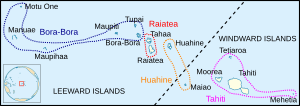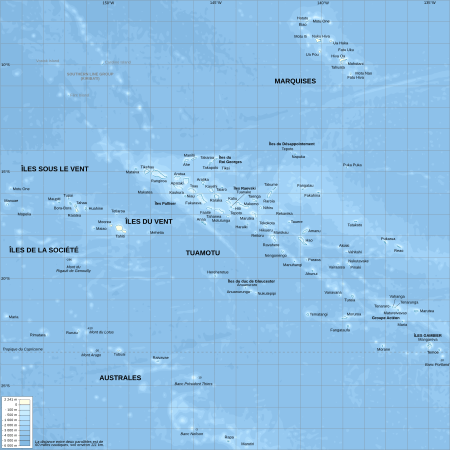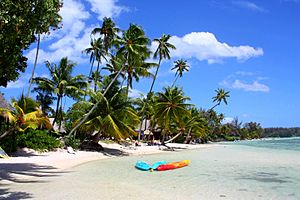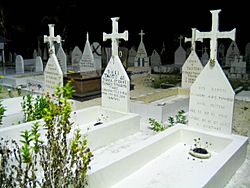French Polynesia facts for kids
Quick facts for kids
French Polynesia
|
|
|---|---|
|
Motto:
|
|
|
Anthem: La Marseillaise(official) Ia Ora 'O Tahiti Nui(unofficial)
|
|
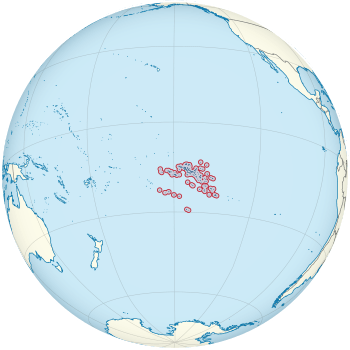 |
|
| Capital | Papeetē |
| Largest city | Fa'a'a |
| Official languages | French |
| Ethnic groups
(1988)
|
|
| Demonym(s) | French Polynesian |
| Government | Dependent territory |
| François Hollande | |
|
• President of French Polynesia
|
Gaston Flosse |
|
• High Commissioner
|
Jean-Pierre Laflaquière |
| Overseas collectivity of France | |
| 1842 | |
|
• Overseas territory
|
1946 |
|
• Overseas collectivity
|
2003 |
| Area | |
|
• Total
|
4,167 km2 (1,609 sq mi) (173rd) |
|
• Water (%)
|
12 |
| Population | |
|
• Jan 2010 estimate
|
267,000 (177th) |
|
• Aug 2007 census
|
259,596 (177th) |
|
• Density
|
63/km2 (163.2/sq mi) (130th) |
| GDP (nominal) | 2006 estimate |
|
• Total
|
US$5.65 billion (not ranked) |
|
• Per capita
|
US$21,999 (not ranked) |
| Currency | CFP franc (XPF) |
| Time zone | UTC-10, −9:30, -9 |
| Driving side | right |
| Calling code | +689 |
| ISO 3166 code | PF |
| Internet TLD | .pf |
|
|
French Polynesia is an overseas collectivity of the French Republic; collectivité d'outre-mer de la République française (COM), sometimes unofficially referred to as an overseas country; pays d'outre-mer (POM). It is composed of 118 geographically dispersed islands and atolls stretching over an expanse of more than 2,000 kilometres (1,200 mi) in the South Pacific Ocean. Its total land area is 4,167 square kilometres (1,609 sq mi).
French Polynesia is divided into 5 groups of islands: The Society Islands archipelago composed of the Windward Islands and the Leeward Islands, the Tuamotu Archipelago, the Gambier Islands, the Marquesas Islands and the Austral Islands. Among its 118 islands and atolls, 67 are inhabited. Tahiti, which is located within the Society Islands, is the most populous island and the seat of the capital of the collectivity, Pape'ete. Although not an integral part of its territory, Clipperton Island was administered from French Polynesia until 2007.
Following the Great Polynesian Migration, European explorers visited the islands of French Polynesia on several occasions. In 1842, the French took over the islands and established a French protectorate they called Etablissements des français en Océanie (EFO) (French Establishments/Settlements in Oceania). In 1946, the EFOs became an overseas territory under the constitution of the French Fourth Republic, and Polynesians were granted the right to vote through citizenship. In 1957, the EFOs were renamed French Polynesia. Since 28 March 2003, French Polynesia has been an overseas collectivity of the French Republic under the constitutional revision of article 74, and later gained, with law 2004-192 of 27 February 2004, an administrative autonomy; two symbolic manifestations of which are the title of the President of French Polynesia and its additional designation as an overseas country.
Contents
History
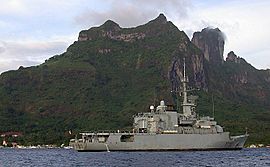
French Polynesia as we know it today was one of the last places on Earth to be settled by humans. Scientists believe the Great Polynesian Migration happened around 1500 BC as Austronesian people went on a journey using celestial navigation to find islands in the South Pacific ocean. The first islands of French Polynesia to be settled were the Marquesas Islands in about 200 BC. The Polynesians later ventured southwest and discovered the Society Islands around AD 300.
European communication began in 1521 when Portuguese explorer Ferdinand Magellan, sailing in the service of the Spanish Crown, sighted Puka-Puka in the Tuāmotu-Gambier Archipelago. In 1772, Dutchman Jakob Roggeveen came across Bora Bora in the Society Islands.
British explorer Samuel Wallis visited Tahiti in 1767. The French explorer Louis Antoine de Bougainville visited Tahiti in 1768, while the British explorer James Cook visited in 1769. In 1772, The Spanish Viceroy of Peru Don Manuel de Amat ordered a number of expeditions to Tahiti under the command of Domingo de Bonechea who was the first European to explore all of the main islands beyond Tahiti. A short-lived Spanish settlement was created in 1774. and for a time some maps bore the name Isla de Amat after Viceroy Amat. Christian missions began with Spanish priests who stayed in Tahiti for a year. Protestants from the London Missionary Society settled permanently in Polynesia in 1797.
King Pōmare II of Tahiti was forced to flee to Mo'orea in 1803; he and his subjects were converted to Protestantism in 1812. French Catholic missionaries arrived on Tahiti in 1834; their expulsion in 1836 caused France to send a gunboat in 1838. In 1842, Tahiti and Tahuata were declared a French protectorate, to allow Catholic missionaries to work undisturbed. The capital of Papeetē was founded in 1843. In 1880, France annexed Tahiti, changing the status from that of a protectorate to that of a colony. The island groups were not officially united until the establishment of the French protectorate in 1889.
In the 1880s, France claimed the Tuamotu Archipelago, which formerly belonged to the Pōmare Dynasty, without formally annexing it. Having declared a protectorate over Tahuata in 1842, the French regarded the entire Marquesas Islands as French. In 1885, France appointed a governor and established a general council, thus giving it the proper administration for a colony. The islands of Rimatara and Rūrutu unsuccessfully lobbied for British protection in 1888, so in 1889 they were annexed by France. Postage stamps were first issued in the colony in 1892. The first official name for the colony was Établissements de l'Océanie (Establishments in Oceania); in 1903 the general council was changed to an advisory council and the colony's name was changed to Établissements Français de l'Océanie (French Establishments in Oceania).
In 1940, the administration of French Polynesia recognised the Free French Forces and many Polynesians served in World War II. Unknown at the time to the French and Polynesians, the Konoe Cabinet in Imperial Japan on 16 September 1940 included French Polynesia among the many territories which were to become Japanese possessions in the post-war world. However, in the course of the war in the Pacific the Japanese were not able to launch an actual invasion of the French islands.
In 1946, Polynesians were granted French citizenship and the islands' status was changed to an overseas territory; the islands' name was changed in 1957 to Polynésie Française (French Polynesia). In 1962, France's early nuclear testing ground of Algeria became independent and the Moruroa atoll in the Tuamotu Archipelago was selected as the new testing site; tests were conducted underground after 1974. In 1977, French Polynesia was granted partial internal autonomy; in 1984, the autonomy was extended. French Polynesia became a full overseas collectivity of France in 2003.
In September 1995, France stirred up widespread protests by resuming nuclear testing at Fangataufa atoll after a three-year moratorium. The last test was on 27 January 1996. On 29 January 1996, France announced that it would accede to the Comprehensive Test Ban Treaty, and no longer test nuclear weapons.
Relations with France
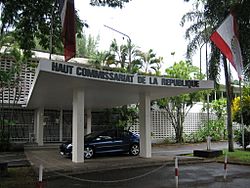
Despite a local assembly and government, French Polynesia is not in a free association with France, like the Cook Islands with New Zealand. As a French overseas collectivity, the local government has no competence in justice, university education, security and defense. Services in these areas are directly provided and administered by the Government of France, including the Gendarmerie (which also polices rural and border areas in European France), and French military forces. The collectivity government retains control over primary and secondary education, health, town planning, and the environment. The highest representative of the State in the territory is the High Commissioner of the Republic in French Polynesia (French: Haut commissaire de la République).
Administration
Between 1946 and 2003, French Polynesia had the status of an overseas territory (French: territoire d'outre-mer, or TOM). In 2003, it became an overseas collectivity (French: collectivité d'outre-mer, or COM). Its statutory law of 27 February 2004 gives it the particular designation of overseas country inside the Republic (French: pays d'outre-mer au sein de la République, or POM), but without legal modification of its status.
Geography
The islands of French Polynesia make up a total land area of 3,521 square kilometres (1,359 sq mi), scattered over more than 2,000 kilometres (1,200 mi) of ocean. There are 118 islands in French Polynesia. The highest point is Mount Orohena on Tahiti.
It is made up of 5 groups of islands. The largest and most populated island is Tahiti, in the Society Islands.
The island groups are:
- Marquesas Islands
- Society Islands
- Tuamotu Archipelago
- Gambier Islands sometimes considered part of the Tuamotu Archipelago
- Austral Islands
- Bass Islands often considered part of the Austral Islands
Aside from Tahiti, some other important atolls, islands, and island groups in French Polynesia are: Ahē, Bora Bora, Hiva 'Oa, Huahine, Mai'ao, Maupiti, Meheti'a, Mo'orea, Nuku Hiva, Raiatea, Taha'a, Tetiaroa, Tupua'i, and Tūpai.
| Commune | Island | Population (2012) |
|---|---|---|
| Fa'a'ā | Tahiti | 29,687 |
| Punaauia | Tahiti | 27,613 |
| Pape'ete | Tahiti | 25,769 |
Economy
The GDP of French Polynesia in 2008 was 7.14 billion US dollars at market exchange rates, the sixth-largest economy in Oceania after Australia, New Zealand, Hawaii, New Caledonia, and Papua New Guinea. The GDP per capita was $27,352 in 2008 (at market exchange rates, not at PPP), lower than in Hawaii, Australia, New Zealand, and New Caledonia, but higher than all the independent insular states of Oceania.
French Polynesia has a moderately developed economy, which is dependent on imported goods, tourism, and the financial assistance of mainland France. Tourist facilities are well developed and are available on the major islands. Also, as the noni fruit from these islands is discovered for its medicinal uses, people have been able to find jobs related to this agricultural industry.
The legal tender of French Polynesia is the CFP Franc.
Agriculture: coconuts, vanilla, vegetables, fruits.
Natural resources: timber, fish, cobalt.
In 2008, French Polynesia's imports amounted to 2.2 billion US dollars and exports amounted to 0.2 billion US dollars. The major export of French Polynesia is their famous black Tahitian pearls which accounted for 55% of exports (in value) in 2008.
Demographics
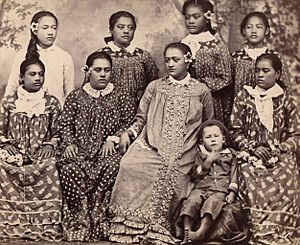
Total population at the August 2012 census was 268,270 inhabitants. At the 2012 census, 68.5% of the population of French Polynesia lived on the island of Tahiti alone. The urban area of Papeete, the capital city, has 133,627 inhabitants (2012 census).
At the 2007 census, 87.3% of people living in French Polynesia were born in French Polynesia, 9.3% were born in metropolitan France, 1.4% were born in overseas France outside of French Polynesia, and 2.0% were born in foreign countries. At the 1988 census, the last census which asked questions regarding ethnicity, 66.5% of people were ethnically unmixed Polynesians, 7.1% were ethnically mixed Polynesians, 11.9% were Europeans (mostly French), 9.3% were people of mixed French and Polynesian descent, the so-called Demis (literally meaning "Half"), and 4.7% were East Asians (mainly Chinese).
Chinese, Demis, and the white populace are essentially concentrated on the island of Tahiti, particularly in the urban area of Papeetē, where their share of the population is thus much greater than in French Polynesia overall. Despite a long history of ethnic mixing, ethnic tensions have been growing in recent years, with politicians using a xenophobic discourse and fanning the flame of nationalism.
Languages
French is the only official language of French Polynesia. An organic law of 12 April 1996 states that "French is the official language, Tahitian and other Polynesian languages can be used." At the 2007 census, among the population whose age was 15 and older, 68.5% of people reported that the language they spoke the most at home was French, 24.2% reported that the language they spoke the most at home was Tahitian, 2.6% reported Marquesan, 1.5% reported Tuamotuan, 1.3% reported any of the Austral languages, 1.0% reported a Chinese dialect (half of which is still Hakka), and 0.9% another language.
At the same census, 94.7% of people whose age was 15 or older reported that they could speak, read and write French, whereas only 2.0% reported that they had no knowledge of French. 86.4% of people whose age was 15 or older reported that they had some form of knowledge of at least one Polynesian language, whereas 13.6% reported that they had no knowledge of any of the Polynesian languages.
Religion
Christianity is the main religion of the islands: a majority (54%) belong to various Protestant churches and a large minority (30%) are Roman Catholic. Slightly more than 50% of French Polynesia's population belongs to the Maói Protestant Church, the largest Protestant denomination. The Church of Jesus Christ of Latter-day Saints had 21,884 members as of 2012. There were about 3,000 Jehovah's Witnesses in Tahiti as of 2014.
Images for kids
-
A two-franc World War II emergency-issue banknote (1943), printed in Papeete, and depicting the outline of Tahiti on the reverse
-
High Commission of the French Fifth Republic
-
Bora Bora, Leeward Islands
-
Painting of Two Women of Tahiti by Paul Gauguin
See also
 In Spanish: Polinesia Francesa para niños
In Spanish: Polinesia Francesa para niños




